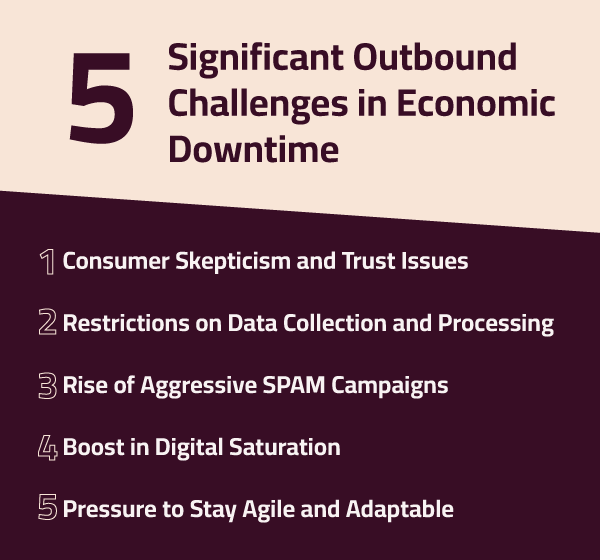
Outbound Marketing Challenges and Their Solutions in Economic Downturn
The economic downturn can rattle your outbound marketing efforts, but you can still seize control. All you have to do is prepare for the obvious and predicted marketing challenges during the crisis. It can range from adjusting your business resources to cutting off unnecessary investments.
Further, recent reports say 75% of multinational companies consider economic crises when planning their advertising and market expenditures. Most companies limit their outreach efforts. But, with our expert guidance, you no longer need to do the same. With resilience and expertise, you can stay ahead, rewrite the narrative, and lead your business through the economic downturn.
So, let us start exploring the major challenges and how to tackle them.
5 Significant Outbound Challenges and Their Solutions During Economic Downturn

In times of economic shifts, the pressure on your outbound marketing strategies becomes inevitable. You may face challenges in managing your resources wisely while striving to provide the best to your target audience. Hence, it impacts your ability to generate leads and maintain a competitive position in the market.
So, let's explore the top challenges with potential solutions that can help you navigate through any downturn:
1. Consumer Skepticism and Trust Issues
At times of economic adversity, consumers become more cautious of what and where they are spending. Reports claim customers show a 22% and 30% trust gap for media, telecom, and industrial products, respectively.
Buyers seek reassurance that their investments are sound and worthwhile. Such a high level of skepticism can create a significant hurdle for outbound marketing.
The traditional methods of persuading consumers might not be right at this moment. Thus, you can adopt the following ways to navigate the business seamlessly:
- Utilize Customer Testimonials and Case Studies: Share honest experiences of your past customers in their own words. You would need to request that they share feedback and testimonials about your products. Plus, you can also create case studies and share them through your cold email campaigns. It’ll build trust and demonstrate the value of your product or service.
In fact, 13% of marketers use case studies as a prime media format in their outreach content strategy.
- Establish a Solid Online Reputation: A robust digital presence is a must for your business. You can establish your brand’s online rapport, preferably with LinkedIn. Here, you can:
- Join relevant groups
- Send personalized connection requests
- Share Inmail
- Partake in industrial discussions and respond to queries.
-to build a relationship.
Further, consistently share valuable content on your prospects’ feeds to maintain a positive image and establish credibility.
- Build Your Physical Presence to Maintain Transparency: Show your brand exists in the real world and you are dedicated to expanding it. Thus, you can highlight your physical presence to reassure your target prospects. You can host some industrial events or an open house. It informs your potential consumers about your business operations and conveys the message of stability as well.
2. Restrictions on Data Collection and Processing
To ensure smooth services for your business, you must prioritize collecting data and insights on your target prospects. However, in times of economic downturn, you may face challenges due to consumer data processing and collection restrictions.
This is primarily because there is a need to balance gathering essential data for effective marketing strategies and addressing privacy concerns. The restrictions imposed during such times can limit your scope. But you can effectively navigate this challenge by taking appropriate steps:
- Find Ways to Get Consent: Collect data with your consumers' consent, even though you are doing outbound marketing. How?
Employ zero-party or first-party data-gathering techniques in your emai outreachl or social media outreach. You can exchange personalized gated research papers, thought leadership content, or relevant quizzes for prospect data.
Valuable and relevancy of your content may push prospects to share their data willingly with you.
- Maintain Compliance: Ensure the data collection follows the latest privacy and data collection policies. Run regular audits, compliance, and data analysis.
- Address Concerns About Data Security: Assure your target consumers about the transparent use of their data. Demonstrate the commitment to their data security by implementing robust cybersecurity measures. It can build trust and help your business stand apart. For businesses and marketers looking to enhance their online privacy and security, using a reliable VPN is essential. You can find a detailed and up-to-date review of NordVPN on Cybernews, which highlights its strong privacy features, speed, and ease of use — crucial factors when protecting your business data during economic uncertainties.
3. Rise of Aggressive SPAM Campaigns
Spam emails account for over 45.3% of the total worldwide mail traffic. It becomes more prominent during uncertainties.
B2B consumers find it hard to segregate what is legit and what is not. Your target consumer may get frustrated and distrustful with the inbox flooded with misleading messages.
Also, at times, your legitimate emails may get lost amidst such emails, reducing the effectiveness of your marketing strategies. But you can avoid this situation using these measures:
- Build Your Email List and Clean It Up Regularly: Construct a robust email list by consistently adding new subscribers and periodically removing inactive or disengaged contacts. It enhances deliverability and maintains a healthy communication channel.
- Authenticate Your Email: Set up records such as:
- SPF (Sender Policy Framework), DKIM (DomainKeys Identified Mail)
- DMARC (Domain-based Message Authentication, Reporting, and Conformance)
These ensure your emails are safe to open. Doing so also helps you to stand out from your competitors.
4. Boost in Digital Saturation
55% of marketers have been creating and posting digital content more often. In the fear of losing customers, companies may amplify their media presence during the economic crisis. Thus, you might face saturation in online spaces.
Thus, gaining your consumer's attention becomes challenging. The following steps can give you a quick advantage:
- Use Innovative Ideas to Capture Attention: Leverage creativity to build a brand new image even when the market is saturated. You can do the following:
- Use social media platforms to share a variety of posts.
- Create interactive content, such as videos, quizzes, etc, to engage.
- Use the latest technology, like chatbots, to capture attention.
- Use Targeted Channels: Utilize specific and focused communication channels to reach out to your intended audience. Tailor your outreach efforts to the platforms or mediums most relevant to your target demographic and enhance the effectiveness of your message.
5. Pressure to Stay Agile and Adaptable
You may find yourself facing the reality that strategies that once thrived in stable economic conditions may now require some adjustments. The market, along with consumer behavior and competition, is in a constant state of evolution. It demands flexibility in your business approach.
Thus, you may feel pressured to reassess, adapt, and navigate the dynamic landscape with resilience. Here’s how you can build resilience with outbound:
- Assess the Market Landscape: To stay ahead, you need to regularly analyze the market situation. Keep a close eye on market trends, listen to customer feedback, and closely monitor performance metrics.
- Stay Nimble: Regularly review your strategies and be ready to make necessary changes based on the dynamic market conditions.
- Run Campaign Tweaks for Optimal Performance: Ensure your outbound marketing campaigns are not set in stone. Regularly tweak them to align with the evolving market landscape. It includes adjusting the focus to different channels that resonate with your audience.
- Align with Consumer Sentiments: Consumer sentiments change, and so should your message. Stay attuned to the shifting preferences and modify your messaging to connect with your audience on a deeper level.
- Review Regularly: Don't wait for major shifts; consistent review is key. Regularly assess the market, adapt campaigns, and fine-tune your approach based on the ever-changing dynamics of customer preferences and market trends.
Adapting to the challenges during economic downtime requires strategic planning, creative thinking, and flexibility. By addressing these issues head-on, you can maintain a strong outbound marketing presence, even in the face of economic uncertainties.
Key Performance Indicators (KPIs) For Outbound Marketing Efforts
As you engage in outbound marketing, it's vital to monitor your progress regularly. Set KPIs in advance to track success, make informed decisions based on data, and tweak tactics for improved results. Here are some essential KPIs for your outbound marketing efforts:
- Lead Quality: It measures the conversion potential of leads, indicating the effectiveness of targeting and engagement strategies in outbound marketing.
- Lead Volume: It reflects the total number of leads generated, showcasing the reach and initial impact of outbound marketing campaigns.
- ROI (Return on Investment): It estimates the profitability of outbound campaigns by comparing generated revenue against marketing expenditures.
- Conversion Rate: It indicates the percentage of leads that become customers, measuring the success of outbound marketing in driving purchases.
- CPL (Cost Per Lead): It evaluates the cost efficiency of marketing efforts, calculated by dividing total campaign costs by the number of leads generated.
Formula: Cost per Lead = Cost of Lead Generation/Total Number of Leads
- Sales Revenue: The total income generated from sales through outbound marketing directly indicates campaign success.
- Customer Retention Rate: It measures the rate at which new customers acquired through outbound marketing continue to engage and make repeat purchases.
Formula: Retention rate = The number of active customers continuing to subscribe/ The total active customers at the start of a period
Conclusion
You must rethink your outbound marketing strategies in times of economic downturn. Prioritize adaptability and informed decision-making to navigate these challenging times successfully.
View challenges not as barriers but as opportunities for innovation and growth.
Partner with specialized companies in outbound marketing like Revnew. Our experts can enhance your outreach strategies amid shifting times. We can implement flexible efforts for a strategic advantage. So, connect with us today to know more.




